Using Virtual Sound Canvas DXi
Last updated on 3/31/2016Still stuck listening to the same puny MIDI sounds from your soundcard but you don't have the money, need, or space for a bulky keyboard workstation? Maybe you're an artist who wants to fill out their productions or a MIDI composer ready to take your songs to the next level. Enter the Edirol Virtual Sound Canvas, modeled after the ubiquitous Roland synth of the same name. Get world-class GM/GS sounds, seamlessly integrated into your DXi-compatible Cakewalk program.
Highlights of the Virtual Sound Canvas
- Almost 1000 sounds including percussion, acoustic, and electronic instruments
- Each instance of VSC can support up to 16 different instruments simultaneously and 128 notes of polyphony
- Up to 16 instances of VSC per project
- Add Reverb, Chorus, Delay and Time Variable Filters to each instrument
- Easily process your MIDI tracks with DirectX effects and export tracks as audio without having to re-record
If you already have Virtual Sound Canvas, read on to learn how to take advantage of all of its features. If you don't already have VSC, this tutorial should give you an idea of how VSC can help you get the most out of your music.
DX Instruments
DXi is the open standard for soft synth plug-ins, and it is based on Microsoft DirectX technology. DXi soft synths provide you with the lowest-latency, most responsive and reliable software synths available for Windows. In addition to the Virtual Sound Canvas, there are many additional synths available from leading manufacturers.
Getting Started
Let's take a look at how to add a DXi to a Home Studio 2002 project (this also applies to other Cakewalk software with DXi-compatibility):
Step 1:
First, insert a blank audio track to your existing project. Do this by either Right-Clicking in the Track Properties pane and choosing Insert Audio Track or by selecting from the Insert Menu.
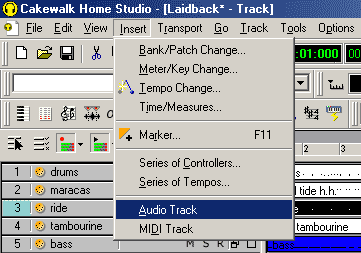
Step 2:
Resize the audio track vertically so that you can see the FX parameter. You do this by putting the mouse over the lower border of the track and then dragging while holding the left mouse button.
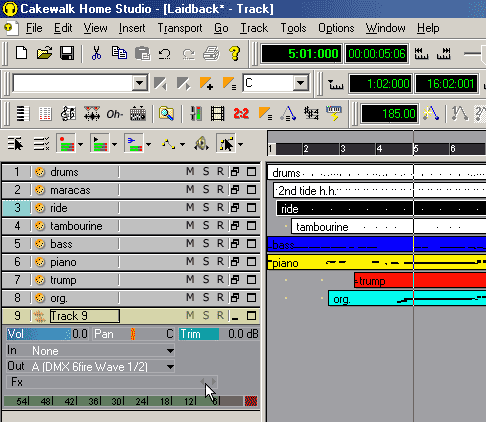
Right-click in the FX bin and select DX Instruments | EDIROL VSC.
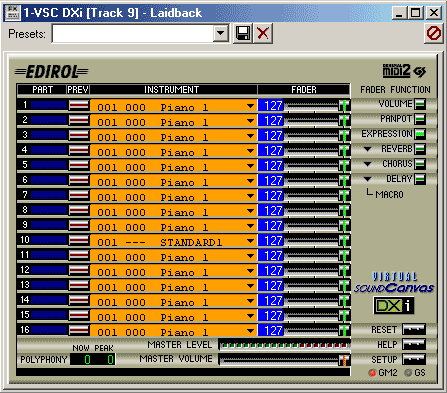
Step 3:
Now we'll assign the outputs of your MIDI tracks to the VSC. There are several ways to do this. You'll notice that you can now choose VSC as an output option for any of your MIDI tracks.
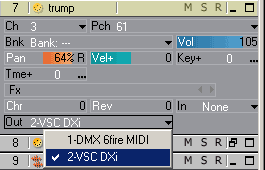
You can also select all tracks ( Edit | Select | Select All) and then change them by going to Tracks | Properties | Outputs | MIDI | VSC DXi.
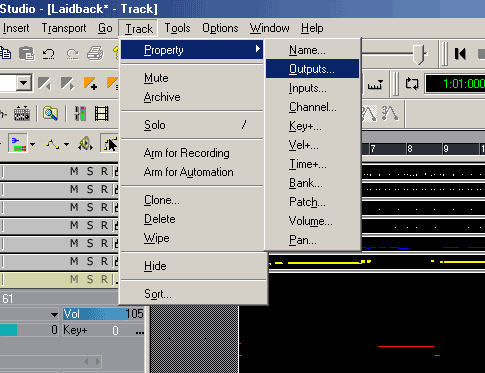
Virtual Sound Canvas DXI in use
- Now that you've loaded up the VSC, let's take a closer look at how it integrates with Home Studio. As we mentioned before, VSC has almost 1000 different sounds in it. These are spread out over 11 sound banks and a dedicated drum bank. You'll be able to select all of these from the Bank selection box on each MIDI track. Now by selecting the Patch Box (PCH) You'll be able to access all of the patches in that Bank. Don't forget to set each of your MIDI tracks to its own MIDI channel.
- If you ever need more than 16 instruments or 128 notes of Polyphony, simply create a new Audio Track and add another instance of VSC. You'll now see another VSC option listed on your MIDI Tracks Output with the appropriate port number in front of it.
- To lower the latency of your DXi's, (the delay between when you play a note and when you hear it), go to Options | Audio | General and lower your Playback Buffers. WDM drivers will always offer superior performance so be sure to check with you soundcard vendor to make sure that you have the latest driver.
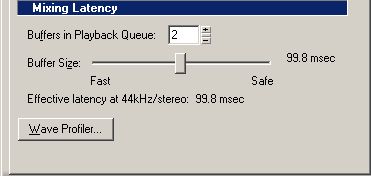
- Because DX Instruments are hosted by an audio track, you can process them with the same DirectX effects you would use on any audio material. Simply right-click in the FX Bin on the track that has the VSC patched and select an audio effect that you would like to use to process the VSC's output. In addition to the effects that ship with your Cakewalk program, there are lots of third-party plug-ins available, some are even offered for free. Below you can see VSC being processed by the free Compressor 1.0 by Richie's Soundtoolz.

- Did you know that Virtual Sound Canvas also has its own built-in effects? Control Reverb and Chorus levels on a per-track basis right from the Track View. For this instance, you'll want to bring up the Chorus (CHR) and Reverb (Rev) levels on the idividual MIDI track that you want to affect.
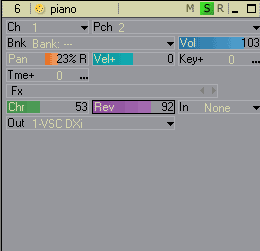
- When you're done, its easy to export your project right to .WAV format for burning a CD, or to MP3, Real Audio, or Windows Media format for internet delivery. What's great about this is that all of your MIDI tracks stay entirely in the digital domain, so there is no degradation of your audio fidelity. When you export the audio, all of your audio FX and instruments will automatically be mixed down.
Simply go to File | Export Audio. You'll see a screen like the following; enter a File Name, choose a Format, and hit Export.
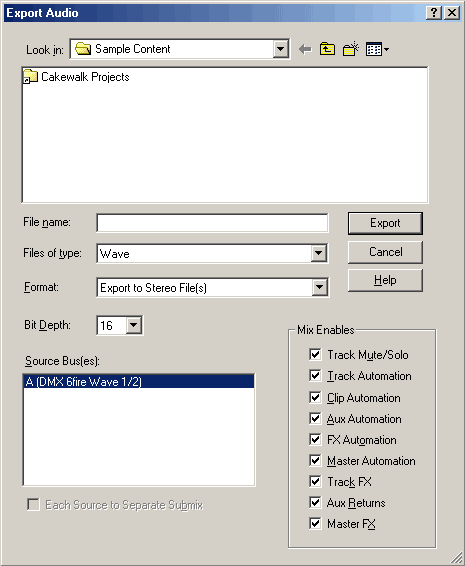
Virtually limitless
Now that we've given you a glimpse of how useful the Virtual Sound Canvas can be (and in fact, all of your DXis), you should be all set to dive right in and try them yourself. Remember, Virtual Sound Canvas and DreamStation DXi come standard with Home Studio 2002, and Home Studio XL ups the ante with the addition of the DR-008 DXi.